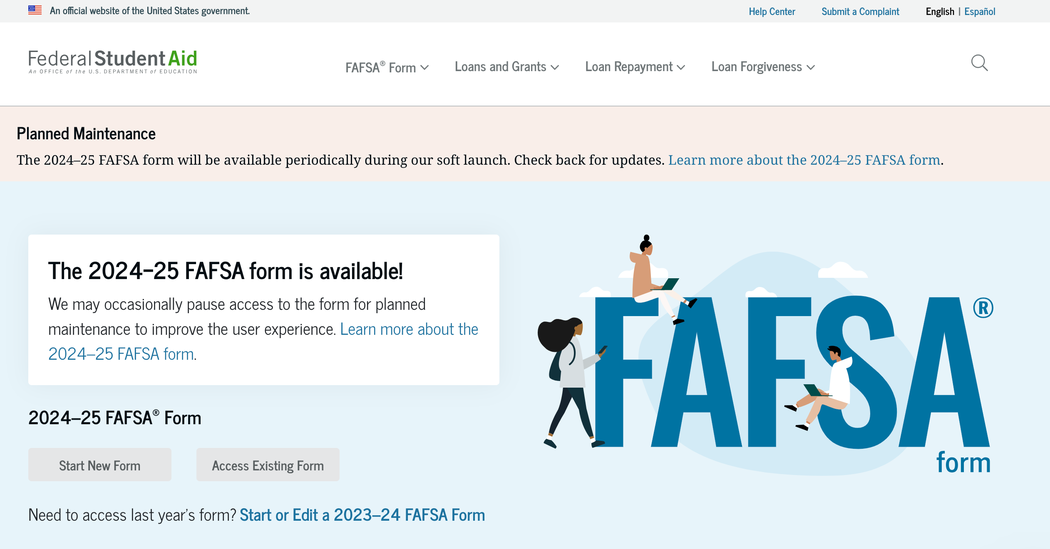Since 2020, when Congress mandated simplification of the federal financial aid system, the U.S. Department of Education has faced the complex task of making changes to the ever-important formula for determining who gets what.
Grants and loans depend on contributions and results from the dreaded FAFSA form, which typically becomes available on October 1. The new form was supposed to debut in 2023, but the department worked hard on it since October, November and December. .
The government promised to open the digital doors by the end of December. My oldest son is going to college this fall, so I spent Sunday afternoon and evening trying to access the site and fill out the form.
Completion proved elusive. This is what happened.
I started around 2 p.m. and the FAFSA (short for Free Application for Federal Student Aid) website greeted me ominously: “The FAFSA form is made available periodically as we monitor the site’s performance and update the form to give you a better experience.” ”.
It was not available at that time, nor at 3, 4, 5, 6 or 7 pm. I started documenting my search on Threads.
Coincidentally (or not), I received an email out of the blue during 6 pm from Johanny Adames, the department’s press secretary, preemptively declaring our off-the-record communication. (That’s a negotiation, not a dictate, in my journalism rule book.)
But the message simply pointed me to a public announcement from the department, which noted that the FAFSA’s promised availability in December was actually a “soft launch” in which the form would be available for “periods of time over the next few days.” However, the statement included the following: “Students and families will be able to complete and submit the 2024-25 FAFSA form online by December 31.”
That seemed like a promise, or at least a challenge, so I kept going. At 8 pm, a Threads user named “jkvaal” started following me. Was it James Kvaal, the Department of Education undersecretary who oversees higher education? He wasn’t trying to ruin anyone’s evening except maybe mine. (My family was elsewhere until later and my 18 year old son helped me remotely.)
Then, also at 8 p.m., success! The site opened and I managed to answer several questions in the “Personal Circumstances” section, which is the first of five sections that together could contain as few as 18 queries, compared to 100 or more in previous versions of the form. .
The site design was clean. The user interface was reasonably friendly. But things were not always clear. At one point, the site was telling me that both my daughter and I had already started the forms when in fact neither of us had, at least as far as I knew.
In the end I kept going, but I didn’t get much further. There was no way, through my daughter’s login, to send me the email that would allow me to grant the Internal Revenue Service permission to insert income data into the form. Well, there was a way, but the email button didn’t work.
Did the form save our data? It was supposed to be, but I couldn’t be sure. There were indications that the Social Security Administration was reviewing his earnings history, so that’s nothing. Once I logged out and tried to log in again to fix the email to your dad issue, the entire site became unavailable again.
The Department of Education did not respond to a request for comment.
There was no need for me, or anyone, to try to fill out the form as soon as the site became available. If you need to fill out a FAFSA this year, the department won’t even send your information to colleges until “later in January.” That said, college financial aid administrators would like to have the information as soon as possible.
The department faces an enormous task here. I have all my sympathy for the government employees who need to improve a website that probably more than 15 million people will use in the coming months. The department staff probably worked over Christmas and I take my hat off to them.
That said, I wish they would have waited another year and fixed this at the end of the summer, so everyone could have a full academic year to get used to the new way and formulas for determining aid. It’s too late for that, unfortunately, so I’m going to keep jumping into this as if I’m Ticketmaster and Beyoncé tickets are up for grabs. Fortunately, federal student loan funds don’t run out, let alone as fast as stadium seats disappear.








